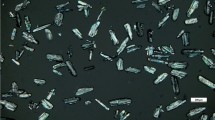Abstract
Purpose. In previous papers, a linear relationship between drug particle size and drug percolation threshold was found in inert matrix tablets. The main objectives of the present work are: to study the influence of the excipient particle size on the drug percolation threshold and to investigate if the change in the drug percolation threshold is due either to the absolute or to the relative drug particle size.
Methods. Matrix tablets have been prepared using KC1 (7 different particle size fractions) as a drug model and Eudragit® RS-PM (4 granulommetric fractions) as matrix forming material. In vitro release assays were carried out on the 66 lots of tablets. The drug percolation thresholds were estimated following the method of Bonny and Leuenberger.
Results. The particle size of the excipient has shown an opposite effect to the drug size on the drug percolation threshold. Nevertheless, the influence of drug and excipient sizes on the drug percolation threshold are of the same magnitude.
Conclusions. The drug percolation threshold depends linearly on the relative drug particle size. This finding is in agreement with percolation theory and can facilitate the use of the percolation threshold as a preformulation parameter to improve the pharmaceutical dosage forms design.
Similar content being viewed by others
REFERENCES
C. Domb. The percolation phase transition. In G. Deutscher, R. Zallen and J. Adler (eds.), Percolation structures and processes, Adam Hilger, Bristol; The Israel Physical Society, Jerusalem; The American Institute of Physics, New York, pp. 17–46 (1983).
D. Stauffer and A. Aharony. Introduction to Percolation Theory, 2nd ed., Burgess Science Press, London, 1991.
R. Zallen. Percolation: a model for all seasons. In G. Deutscher, R. Zallen and J. Adler (eds.), Percolation structures and processes, Adam Hilger, Bristol; The Israel Physical Society, Jerusalem; The American Institute of Physics, New York, pp. 3–16 (1983).
H. Leuenberger, B. D. Rohera and C. Haas. Int. J. Pharm. 38:109–115 (1987).
J. D. Bonny and H. Leuenberger. Pharm. Acta Helv. 68:25–33 (1993).
J. D. Bonny and H. Leuenberger. Pharm. Acta Helv. 66:160–164 (1991).
D. Blattner, M. Kolb and H. Leuenberger. Pharm. Res. 7:113–117 (1990).
I. Caraballo, M. Fernández-Arévalo, M. Millan, A. M. Rabasco and H. Leuenberger. Int. J. Pharm. 139:177–186 (1996).
I. Caraballo, M. Fernández-Arévalo, M. A. Holgado and A. M. Rabasco. Int. J. Pharm. 96:175–181 (1993).
I. Caraballo, M. Fernández-Arévalo, M. A. Holgado and A. M. Rabasco and H. Leuenberger. Int. J. Pharm. 109:229–236 (1994).
I. Caraballo, M. Millán and A. M. Rabasco. Pharm. Res. 13:387–390 (1996).
S. Budavari (Ed.). The Merck Index. 11th ed., Merck & Co. Inc., Rahway, 1989, p. 7609.
M. Millán, I. Caraballo, M. C. Soriano, L. Melgoza and A. M. Rabasco. Estudio, para valores extremos, de la relación entre el umbral de percolación y el tamaño de partícula en matrices inertes. Abstract book of the III Congreso de la Asociación Española de Docentes de Farmacia Galénica and II Congress of the Controlled Release Society, Spanish-Portuguese Local Chapter. Tenerife, 2–5 Febrero 1997, pp. 113–114.
I. Caraballo, M. A. Holgado, M. Fernández-Arévalo, M. Millán and A. M. Rabasco. Drug Dev. Ind. Pharm. 23:1–8 (1997).
G. Yu. Philosoph. Magazine B 69:95–101 (1994).
A. L. Efros. Física y Geometría del desorden. Ed. Hayka. Moscow, pp. 144–147 (1987).
Author information
Authors and Affiliations
Rights and permissions
About this article
Cite this article
Millán, M., Caraballo, I. & Rabasco, A.M. The Role of the Drug/Excipient Particle Size Ratio in the Percolation Model for Tablets. Pharm Res 15, 216–220 (1998). https://doi.org/10.1023/A:1011906416291
Issue Date:
DOI: https://doi.org/10.1023/A:1011906416291




